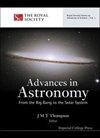暗能量的费米简并反中微子恒星模型
IF 1.2
4区 物理与天体物理
Q3 ASTRONOMY & ASTROPHYSICS
引用次数: 2
摘要
当大型强子对撞机在2021年恢复运行时,几个实验将首次直接测量反氢在自由落体中的运动。我们目前对宇宙的理解还没有为反物质具有负引力质量的可能性做好充分准备。本文提出了一个宇宙学模型,其中大爆炸的高能量密度状态是由一颗超过钱德拉塞卡极限的反中微子恒星的坍缩产生的。为了让第一批中微子恒星和反中微子恒星从初始量子真空状态自然形成,假设反物质具有负引力质量是有帮助的。这一假设也可能有助于识别暗能量。今天,反中微子恒星的简并残骸的平均质量密度与∧CDM模型的暗能量密度相似。当处于流体静力平衡时,这颗反中微子恒星残骸可以发出等温的宇宙微波背景辐射,并径向加速物质。该模型和∧CDM模型在数量上与超新星距离测量结果相似。因此,这个模型作为一个纯粹的学术练习和为未来可能的发现做准备是有用的。本文章由计算机程序翻译,如有差异,请以英文原文为准。
Fermi Degenerate Antineutrino Star Model of Dark Energy
When the Large Hadron Collider resumes operations in 2021, several experiments will directly measure the motion of antihydrogen in free fall for the first time. Our current understanding of the universe is not yet fully prepared for the possibility that antimatter has negative gravitational mass. This paper proposes a model of cosmology, where the state of high energy density of the big bang is created by the collapse of an antineutrino star that has exceeded its Chandrasekhar limit. To allow the first neutrino stars and antineutrino stars to form naturally from an initial quantum vacuum state, it helps to assume that antimatter has negative gravitational mass. This assumption may also be helpful to identify dark energy. The degenerate remnant of an antineutrino star can today have an average mass density that is similar to the dark energy density of the ΛCDM model. When in hydrostatic equilibrium, this antineutrino star remnant can emit isothermal cosmic microwave background radiation and accelerate matter radially. This model and the ΛCDM model are in similar quantitative agreement with supernova distance measurements. Therefore, this model is useful as a purely academic exercise and as preparation for possible future discoveries.
求助全文
通过发布文献求助,成功后即可免费获取论文全文。
去求助
来源期刊

Advances in Astronomy
ASTRONOMY & ASTROPHYSICS-
CiteScore
2.70
自引率
7.10%
发文量
10
审稿时长
22 weeks
期刊介绍:
Advances in Astronomy publishes articles in all areas of astronomy, astrophysics, and cosmology. The journal accepts both observational and theoretical investigations into celestial objects and the wider universe, as well as the reports of new methods and instrumentation for their study.
 求助内容:
求助内容: 应助结果提醒方式:
应助结果提醒方式:


